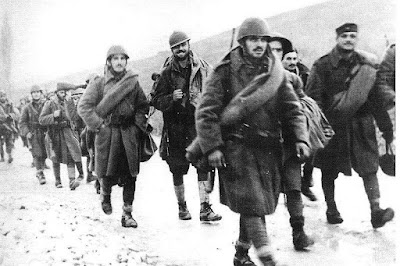This is a Greek Datacard for use with the Spearhead rules and Wargaming.info’s Defence of Florina 1941 mini-campaign.
| Main | Def | AT | AI | RG | AT | AI | Max | SM | Flak | HD | WT | Move |
| Rifles | 5 | 2 | 4 | 6″ | – | – | – | – | – | 0 | – | 6″ |
| HMG Standard | 5 | – | 5 | 9″ | – | – | – | – | – | 0 | – | 6″ |
| HMG 13.2mm | 5 | 2 | 5 | 9″ | – | – | – | – | – | 0 | – | 6″ |
| Mortar (81mm) | 5 | – | – | – | 1 | 4 | 30″ | Y | – | 0 | – | 6″ |
| Inf. Gun (65/17) | 5 | 3 | 5 | 9″ | 1 | 4 | 70″ | Y | – | 0 | – | 6″ |
| Field Gun (75/36) | 5 | 5 | 5 | 9″ | 1 | 4 | 120″ | Y | – | 0 | – | 6″ |
| Med. How (155/15) | 5 | 6 | 8 | 9″ | 3 | 6 | 130″ | Y | – | 0 | – | 6″ |
Modelling The Greek Troops
On paper the Greeks started the war with their M1938 kit, a (vaguely Italian style) uniform and their new helmet (again similar to the Italian one, but in a dark green colour); they also had quantities of French Adrian Helmets in storage that they were replacing. As they mobilised in 1940 against the Italians they reissued the Adrian Helmets (and these were often mixed into units with the new helmets as they seem to have been issued based on when a man was called up or volunteered, so if sent as a reinforcement or replacement to an existing unit he might have an older helmet to what the rest of the unit had); so more of these gradually appeared as the campaign in Albania developed. Most o f the fortress troops in the East almost certainly would have all had the new uniforms initially too..
However the Greek mobilisation meant they could not supply enough uniforms and helmets for all their expanded army, and the new uniforms only being in production for under 2 years mean they did not have a reserve of these. As a result large numbers of British ‘battledress’ style (and older) uniforms were supplied to Greece, along with considerable numbers of older WW1 style Brodie Helmets.
The result was Greek units could vary in appearance from the initial ones at the start of the Italian invasion with entirely M1938 pattern uniforms and helmets, to units with those uniforms and mostly those helmets and odd French Adrian and/or British Brodie helmets mixed in – to units with British Battledress and similar, and almost entirely British Brodie helmets by the time the Germans invaded in April 1941 – especially the late raised Infantry Regiments (e.g. the Dodecanese Regiment) and Divisions (the cobbled together 21st Motorised Division) along with a lot of the later artillery and other support and service troops.
Officers wore mostly British style service caps as far as I can see, but there may have been an official Greek officer’s service cap as part of the new M1938 uniforms that is similar enough to the British oen to be mistaken for it.
In 6mm scale either British or Italian figures can be readily used for Greek Infantry if needed. It doesn’t look like whole units had Adrian helmets so it may not be possible to use French Infantry for them (note: the Greek HMGs, and possibly the 81mm mortars also, were French). There are Greek figures available in 20mm scale so assume by now there may well be some good 6mm Greeks available (there weren’t when I first wrote this mini-campaign in 1996).

As an aside on the French HMGs the Greek’s used, they had small numbers of heavier 13.2mm ones as well, these were issued in small numbers (4-8) to a few divisions as additional Anti-Tank assets to supplement the handful the anti-tank guns available. At least 1 division had 1 platoon of 4 anti-tank guns and 2 platoons of 4 13.2mm HMGs each as it’s entire divisional anti-tank strength. The 13.2mm HMGs penetration with AP rounds would still have been more than adequate to deal with the L3 Tankettes & Armoured Cars, and perhaps the side & rear armour of the Medium Tanks.
Go to Anglo-Greek Briefing, OOB & Deployment or Return to Main Florina Mini-Campaign Page.
